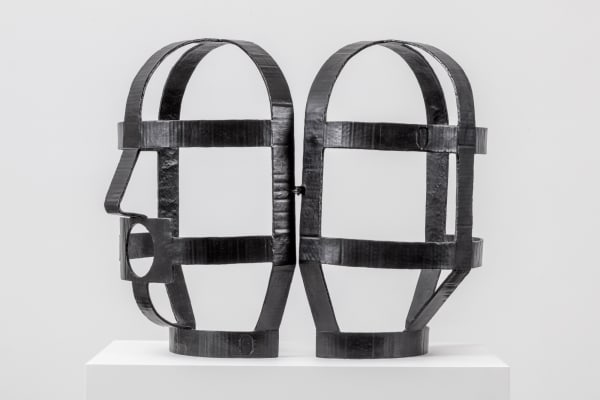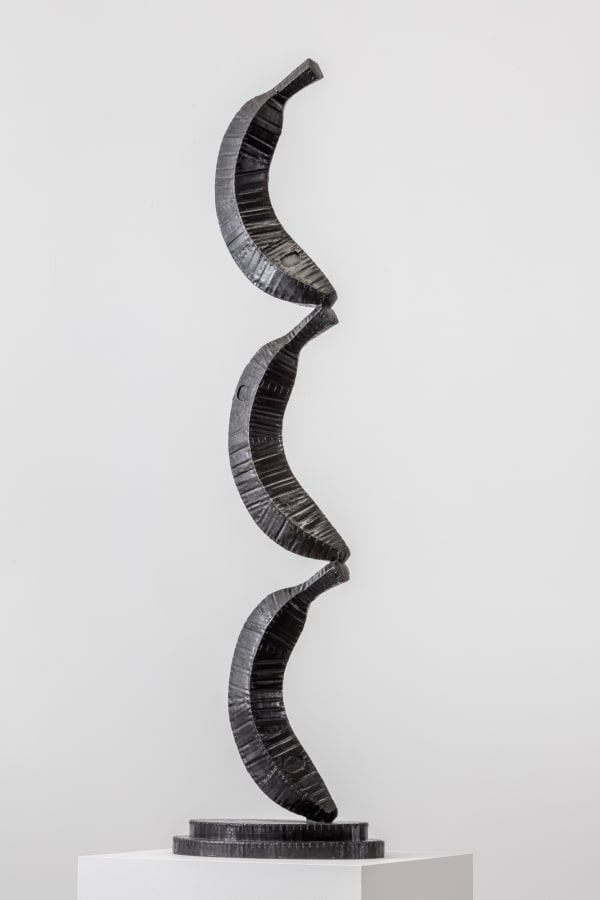Jebila Okongwu: The Legitimacy of Brutality
Jebila Okongwu works in a variety of traditional media—sculpture, drawing, printmaking and painting—but during the past year he’s turned to transforming the found objects that he finds on the streets of Rome into exquisite works of art. Not surprisingly one might think of the Italian Arte Povera movement in the 1960s, which, like Pop Art, used everyday popular images and materials to alchemically turn them into art (one critic called Okongwu the “African Andy Warhol”). For Jebila these are two-and-three-dimensional works made from discarded cardboard boxes used to transport bananas. His inspiration comes from the graphics, the colors and also the physical material of these boxes.
For his one-person exhibition at Baert Gallery he not only references the power that these found materials have to become high art but also highlights his roots as a classically trained artist, showing both bronze sculptures and intricately worked paintings. There is one painting with painstakingly sliced bits of cardboard attached to a blank surface and treated with acrylic paint. Another is a literal transformation of the cardboard painting, via precise brushstrokes, onto a large canvas.
Born in London, Okongwu spent his early childhood in Nigeria, where his father was born. When he was still young he moved with his mother to Australia, where he grew up and eventually studied art in Melbourne. These mixed cultural experiences clearly inform his art, from the Igbo tribal sculpture of his father’s heritage to the Anglo-European influences of having lived in Australia.
The complexities of his background are visible in his artistic production and Jebila delves into them with an approach that is, at its roots, multicultural. He lives in Italy and his technique comes mostly from European art: think of Rodin’s bronzes, Raphael’s paintings and Picasso’s prints. All three media—as different as they are—convey messages that evoke the greater meanings of a singular but also universal life.
For this exhibition Jebila has produced several works referencing identity, sexuality, beauty in very subtle but exciting ways. The volcano (think of Pompeii and Mount Etna) is a significant presence. Power, nature, violence are some underlying themes but the beauty of surface and materials remind us that simplicity and precise technical skill are essential to brilliant art.
Masks also are ever present in this exhibition since we, as social beings, must often present a constructed sense of ourselves to the outside world. Jebila’s mask paintings recall his African heritage but also fundamental issues that affect us everyday. These questions are raised in a poignant way compelling the viewer to think as well as enjoy the inherent beauty. It is a perfect segue of blending the conceptual with the aesthetic.
As a first class draughtsman, his drawings and prints are a testimony to this. But his paintings are also clearly mapped out before being painted with a variety of brushes to give them the differing texture, surface quality and form that is necessary to communicate the complexity of the message. The brushstrokes are intensely accurate reiterations of painting techniques found since the Renaissance and some sculptures refer to the strength and brilliance of bronze, a material that dates back centuries.
Drawing and printmaking have an immediacy that can be comprehended but also allow viewers an insight into the artist’s inner thoughts. Posters and graphics have had (and still do) important historical influence on political movements. This all comes together in Jebila’s exhibition and it is a poignant sign of the times done with nuance and grace, which is what I think we need today.
Elizabeth Janus, Rome, February 2017.
-
 Jebila OkongwuThe Legitimacy of Brutality, 2016Oil on linen
Jebila OkongwuThe Legitimacy of Brutality, 2016Oil on linen -
 Jebila OkongwuUntitled, 2016Oil on linen
Jebila OkongwuUntitled, 2016Oil on linen -
 Jebila OkongwuUntitled, 2016Oil on linen
Jebila OkongwuUntitled, 2016Oil on linen -
 Jebila OkongwuUntitled, 2016Bronze
Jebila OkongwuUntitled, 2016Bronze -
 Jebila OkongwuBanana Sculpture #23, 2016Bronze
Jebila OkongwuBanana Sculpture #23, 2016Bronze -
 Jebila OkongwuUntitled, 2016Mixed media collage on linen
Jebila OkongwuUntitled, 2016Mixed media collage on linen -
 Jebila OkongwuUntitled, 2016Mixed media collage on linen
Jebila OkongwuUntitled, 2016Mixed media collage on linen -
 Jebila OkongwuUntitled, 2016Mixed media collage on linen
Jebila OkongwuUntitled, 2016Mixed media collage on linen -
 Jebila OkongwuUntitled, 2016Mixed media on linen
Jebila OkongwuUntitled, 2016Mixed media on linen -
 Jebila OkongwuUntitled, 2016Mixed media collage on linen
Jebila OkongwuUntitled, 2016Mixed media collage on linen -
 Jebila OkongwuUntitled, 2016Mixed media collage on linen
Jebila OkongwuUntitled, 2016Mixed media collage on linen -
 Jebila OkongwuUntitled, 2016Mixed media collage on linen
Jebila OkongwuUntitled, 2016Mixed media collage on linen


















